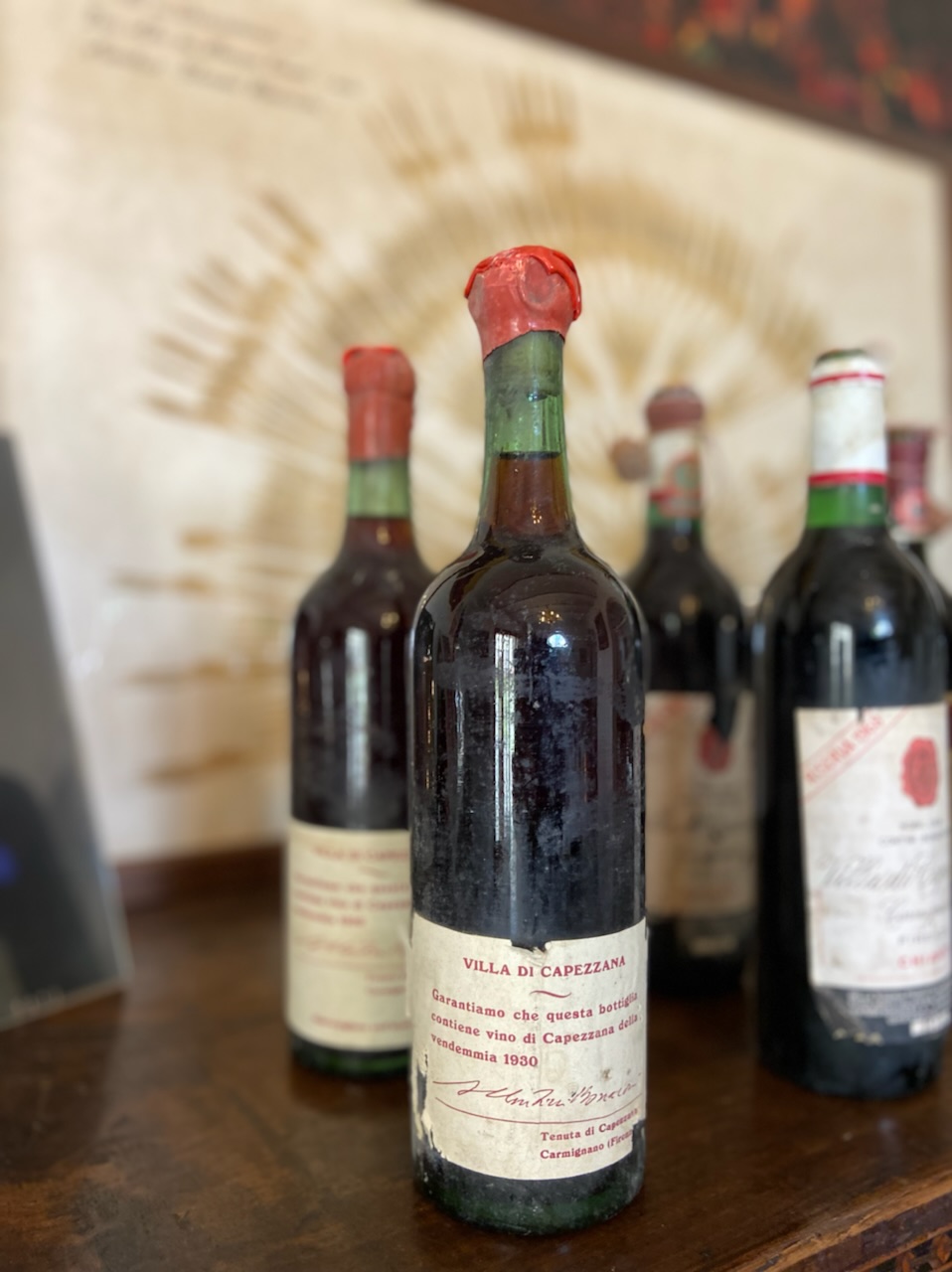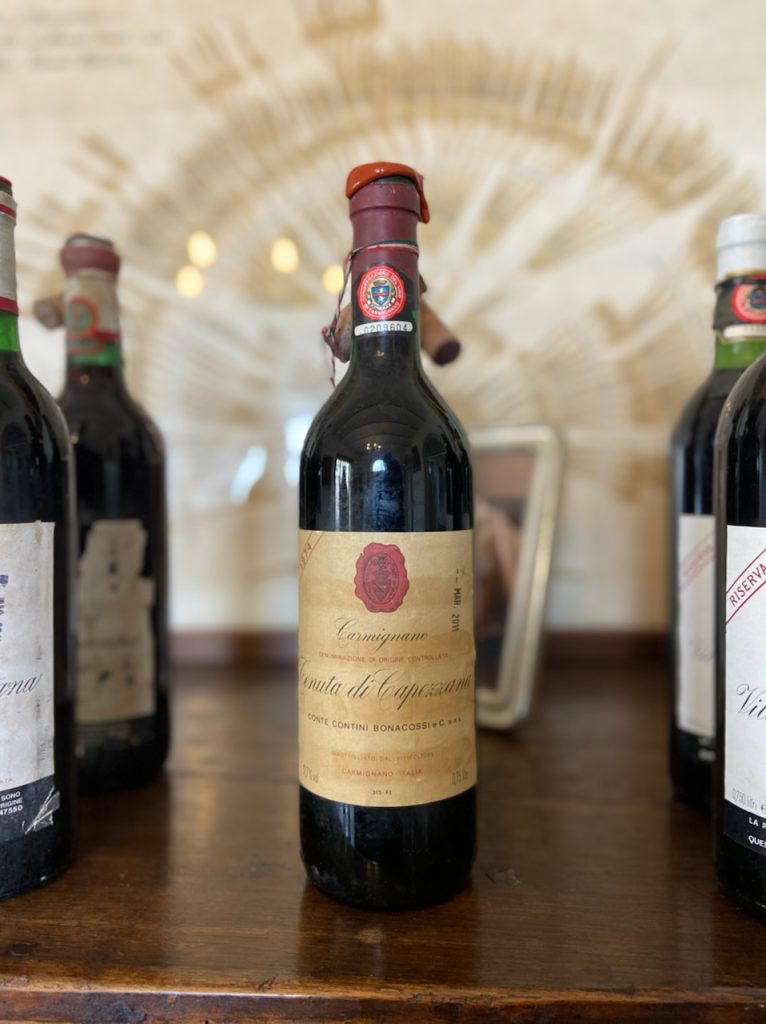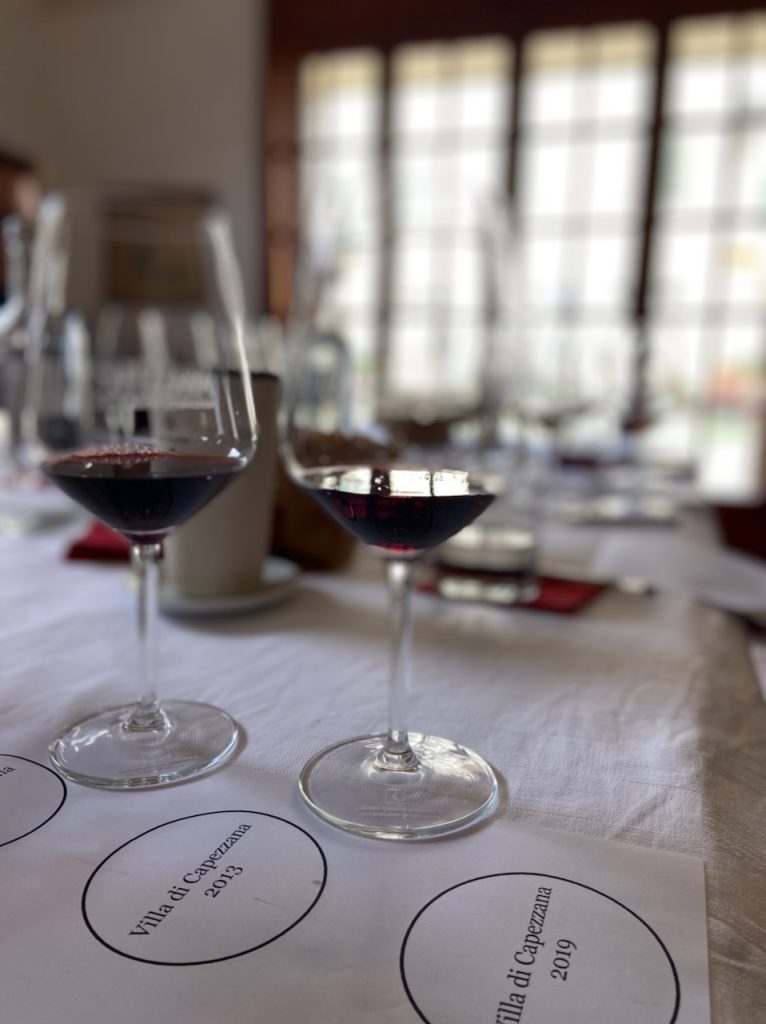Carmignano: ‘here [it] is a little heaven for vines’
A few miles west of Florence in a remote Tuscan farmhouse in the tiny appellation of Carmignano lies what could be one of Italy’s best kept secrets – Villa di Capezzana. Filippo Bartolotta tastes one of the last bottles from the “outstanding” 1930 vintage, as part of a historic vertical.

It was the year the Graf Zeppelin Airship completing the flight from Germany to Brazil, when Betty Boop made her debut, and television was starting to gain momentum. But it was also the first year of the great depression when 1,350 US banks failed. Meanwhile in Italy Corradino D’Ascanio – the future inventor of the Vespa moped in 1946 – succeeded in getting the first modern helicopter to fly 20 meters high for almost 10 minutes around Pescara. It was a very short flight and maybe a forgotten page of history but nonetheless an important one.
That year in a remote Tuscan farm, a few miles west of Florence, Conte Alessandro Contini Bonacossi, dear friend with Baron Eric de Rothschild of Chateau Lafite, bottled of one of Italy’s best kept, but also little known, fine wine, Tenuta di Capezzana, Villa di Capezzana 1930.
Benedetta and her sister Beatrice are sitting at the table with me while we taste the old vintages. They are both silent and very focused on the tasting. After a few minutes, I ask Beatrice about data on the 1930 harvest.
“We can see from the documents that it was an outstanding season where we had enough rain showers though winter and spring. The summer was hot helping a perfect maturation,” she tells me. And what about the blend I ask Benedetta. “There was at least a 70% of Sangiovese some Canaiolo and Cabernet Sauvignon and other varieties, maybe some white ones as well,” she replies.
The two sisters go back and forth telling the stories of the families, along with the agronomical and eonological notes on the wines.
The Contini Bonacossi family had purchased the estate of Tenuta di Capezzana in the early 1920’s but the passion for fine wines made them keep a few bottles of each vintage since the beginning vintage 1925. The 1930 bottle we tested on an exclusive tasting for The Drinks Business was one of the 100 left in the caveau.
Tenuta di Capezzana is a 650 ha farm with 80ha of vines and 140ha of olives located in Carmignano a few miles away from Florence and one of the oldest and yet little known wine making region in Tuscany. Here, Sangiovese is still the king, always blended with the local floral and elegant Canaiolo Nero. But this region is famous also for the presence in the blend of Cabernet Sauvignon. This latter has been cultivated here as early as the1700s. The tiny appellation of Carmignano – only 100 ha total – gained is DOCG status in 1990.
While driving with the agronomist Gaddo Contini Bonacossi in his beloved green Land Rover on the limestone-rich soils, I notice the April sunshine shining on the new budding of the Sangiovese vines. It’s already pretty hot here, “but during the night temperatures drop drastically” says Gaddo stopping the car.

“This breeze is also paramount for our organic farming, it comes from the Apennine mountain range, and together with the very well drained soils here is a little heaven for the vines,” he explains.
Today Capezzana is managed by a collaboration between the fourth and fifth generation. Beatrice is the sales manager, supported by her sister Benedetta, the winemaker, and by her brother Filippo, responsible for the production of oil and the financial side. The fifth generation has already begun to follow the family tradition with Serena, hospitality manager, and Gaddo. But a lot of what happened in Capezzana is linked to the name of Alessandro’s son Ugo Contini Buonaccossi. A war veteran with a degree in agriculture, who gradually took over the management of the estate, transforming it from a sharecropping business to a modern company. Ugo, a man of other times but broad-minded, exploited the enthusiasm and passion of his sons, leaving each of them to manage a business.
I have been enjoying tasting some of the older vintages also with Conte Ugo, who passed away in 2012 but it was only a couple of years ago that my palate and my heart was struck by the mightiness of Capezzana when I found a pristine bottle of 1937 purchased at Enoteca di Pitti Gola e Cantina and opened the same night at one of Florence most traditional Trattoria ‘Da Cammillo’. The fabulous old school waiters wanted to leave the honour – and responsibility – to open the bottle. The cosy, noisy and buzzing tiny trattoria became silent all of a sudden. All eyes on us and that Tenuta di Capezzana, Villa di Capezzana 1937.
The cork came out all right, I got myself a drop in the glass and everyone must have seen my happy eyes as everyone started to chat again and applauded. I have a drop to a couple of German tourist near me and to the waiters and the owner Chiara. The fried lamb and sweetbreads arrive just on time. The combination of sweet red fruit, broom flowers, liquorice, incense, mint and leather and the juicy mouthful was just divine. It was a fantastic evening which got me to ask the winery to host this vertical tasting.
Here are the tasting notes of the Villa di Capezzana vertical. Al the wines till the 70’s are a blend 70% Sangiovese, 10% Cabernet Sauvignon and 10% of other varieties like Canaiolo, Trebbiano ecc. The Wines were aged a couple of years in big 24 HL barrels. From the early 80’s however, the final blend is 80% Sangiovese and 20% Cabernet Sauvignon, aged for two years in 350L tonneaux.
Tasting notes

Tenuta di Capezzana, Villa di Capezzana 1930.
A transparent pale garnet colour with the most enticing combination of lemon-thyme, dry roses, redcurrant and lavender flowers. On the palate the tannins are seamless, it’s fragile and yet with a zesty acidity and wonderful cardamom peppermint and propolis spices. Aged in 24 hectolitres old Italian Botti this wine is a true champion of delicious finesse.
Partner Content
Tenuta di Capezzana, Villa di Capezzana 1968
A richly balsamic nose with a beautiful gunpowder, cedar wood, incense, goji berries, green pepper and sage notes. The nose of this wine is tremendously complex and its intensity would later appear on the palate also with some licorice, bee wax, wild violets, dry cranberries and a refreshing arabica espresso finish.
This vintage was in the hands of Beatrice and Benedetta’s father, Ugo.
Tenuta di Capezzana, Villa di Capezzana 1974
Leather, shiitake mushrooms, leather, quinine and rhubarb with a sour cherry and dry prunes. The palate is way more robust then the previous vintage with some high acidity and a very reactive finish, but still extremely intact.
This vintage was still made by Ugo Contini Bonaccossi and oenologist Vittorio Fiore.
Tenuta di Capezzana, Villa di Capezzana1981
Acacia flowers, echinacea, violets and red berries. A very gentle and elegant nose with a velvet tannic structure and a mesmerizing fresh sage and rosemary flowers. This wine shows the potential of this terroir where the aging potential is always linked to delicate traits.
Tenuta di Capezzana, Villa di Capezzana 1988
The colour is much deeper and darker. On the nose is gun flint, smoke with a very intriguing combination of blue flowers, blackcurrants and eucalyptus. On the palate the wine shows some serious tannic structure with a great orange zest, dry herbs, dark chocolate and leather. This wine was made by Benedetta Contini Bonacossi with winemaker Stefano Chioccioli.
Tenuta di Capezzana, Villa di Capezzana 2005
Dark purple hues with a resembling darker nose of blueberries, chocolate, pencil shavings, vanilla and cinnamon. Some of the oak pieces blend perfectly with some intense medicinal herbs and black cherry juice. This wine has got a rougher edge then the other wines tasted so far but also a very interesting salinity vein which adds up a lot of energy.
still dark side, blueberry, with a spacing of Taraceau (not only cooked pear) cherry, sour cherry, hints of citrus, blue flowers, juiciness salinity, gentian
Tenuta di Capezzana, Villa di Capezzana 2013
Liquorice, wild fennel, leather and black berries. A lot of menthol, thyme and a smoky trait. On the palate there’s a XVth Century fortress structure with some serious strength balanced out by an elegant juiciness which helps melting some of the tannins down. This vintage is the first year of collaboration with Bernabei as a wine maker starting to work again with indigenous yeast.
Tenuta di Capezzana, Villa di Capezzana 2019
Very intense purple red colour. A classic wild violet, raspberries, peppermint and Capezzana distinctive sage flowers nose. on the palate the wine seems to be a bit shy or I should have said austere but then after a few minutes, just like Benedetta and Beatrice, it becomes more open friendly with a lot to say, revealing a great depth and complexity. A powerful wine still very young. Needs time. The aging of this wine went through 500l tonneaux and also some big botti.
Related news
For the eleventh day of Christmas...




